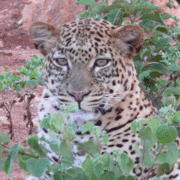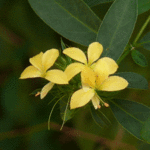19th March 2008 : Honey and Big Skies
 Wednesday, March 19, 2008 at 02:14PM
Wednesday, March 19, 2008 at 02:14PM Written last night but was too tired to post, so here we go now...
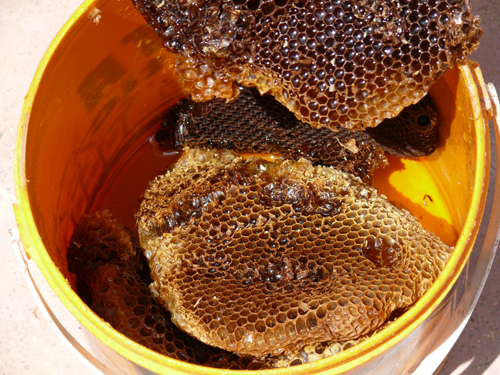
Look at this feast! Today our trusty beehives delivered this bounty, despite there being rather a shortage of bees around this year…obviously enough to make enough honey to go round for us and the guys that work for us. The hives we use are traditional Wakamba beehives: hollowed out logs hung in the trees with wire. They’re not the most efficient type of beehive in the world: we’re planning to buy some more modern, more efficient hives soon. In the meantime, it’s important when harvesting the honey not to take all the combs out of each hive, otherwise there’s nothing left for the bees…I squeezed the incredibly sweet honey out of the combs by hand, which was a sticky experience but well worth it…there’s nothing quite like a slice of homemade bread, fresh out the oven and still warm, with honey from one’s very own beehives…
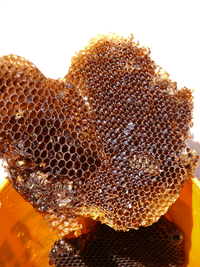
Oozing honey...
Click any image to enlarge
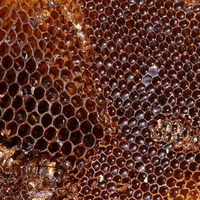
Honeycomb in close-up
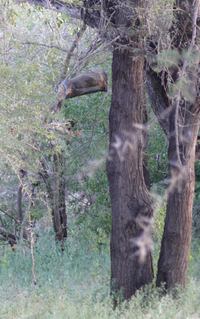
The generous beehive hanging from a tree near the Peaceful Place
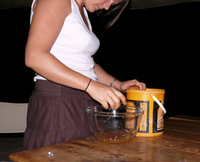
Squeezing the honey out of the comb
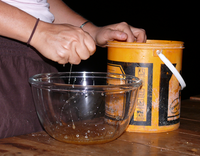
A sticky business!
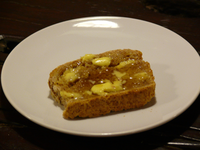
The reward: homemade bread and honey...
On the culinary front, I’ve recently started making kefir – for anyone who doesn’t know what this is, it’s a drink/food very like natural yoghurt but apparently with even more health benefits. You start with some ‘grains’ (which I got from a friend – her grandmother kept the same culture going for 60 years by looking after those all important grains), put them in milk overnight, and by morning you have a thin yoghurt-like mixture with myriad health benefits. (Even Ian has been persuaded of this, and has a daily glass into which he mixes a little honey.) After making a jugful, you have to carefully put the grain in some water (or milk) to keep it alive and ready to make the next batch. Learn more about kefir here.
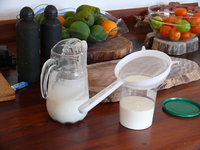
Sieving the kefir to retrieve the all-important grain
click any image to enlarge

This ugly-looking lump - a mixture of bacteria and yeast - is the magic-maker: this is the all-important kefir "grain"
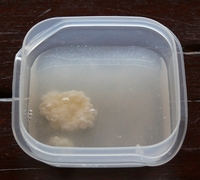
If placed carefully in water, you can keep the kefir lying dormant until you want to make your next batch...
Ian thinks it’s like “The Good Life” all over again [a 1970s English comedy series where a Do-It-Yourself couple tried to live off the land in their tiny English town house, overlooked with amused disdain by their upper-crust neighbours.]….just wait until we have our own elephant- and baboon-proof, super-fortified veggie patch!
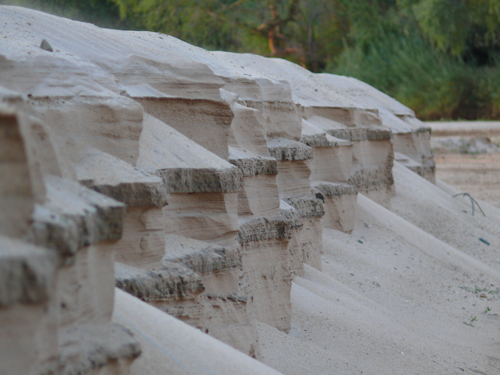
My goodness it has been HOT – you sweat just getting out of the bed in the morning! The river has been very low, and a huge new mud flat has opened up on Hippo Bend, with interesting sand formations being created by the wind where the mud meets the sand. There were lots of ‘track stories’ on the beach when we were down there the other evening…telling of the passing elephants, and the baboons who were running just ahead of us on the beach, and of storks walking in perfect parallel, and even of the cheetah who’s been back here drinking again….or is this a hyena footprint? They are so difficult to tell apart, and we’ve been hearing a lot of hyena noise around the house recently, loud whooping and the distinctive chuckling noise they make which leads people to say that hyenas laugh…
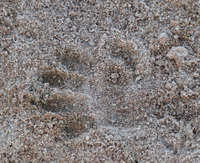
Baboon footprint (the thumb makes it distinctive)
click any image to enlarge
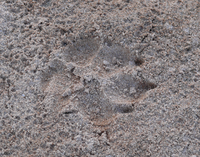
Fresh cheetah pug mark
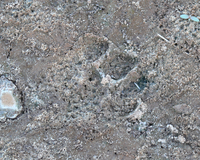
Lion paw print
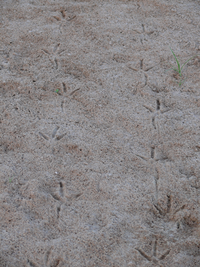
Parellel Storks...
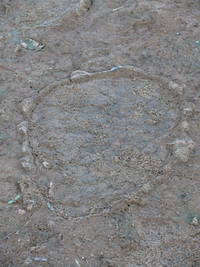
Elephant footprint - just as if someone's plonked a great big bucket on the mud!
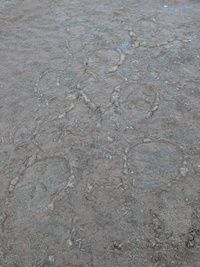
Elephant footprint patterns
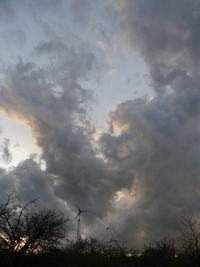 The searing heat has been pulling in great tall rain clouds and it looks like the rainy season is about to start any day now, with huge wild skies and towering clouds and the smell of moisture on the hot, hot air. Because the last rainy season ended so late here in Tsavo, it seems strange to be contemplating rain again already, but it certainly does seem to be on its way. The wind in the evenings, as the sun slips below the horizon and the temperature drops, has been unbelievably fierce…in fact, it’s been blowing so hard, we think something has snapped in our wind turbine which is looking decidedly sluggish despite the raging winds…
The searing heat has been pulling in great tall rain clouds and it looks like the rainy season is about to start any day now, with huge wild skies and towering clouds and the smell of moisture on the hot, hot air. Because the last rainy season ended so late here in Tsavo, it seems strange to be contemplating rain again already, but it certainly does seem to be on its way. The wind in the evenings, as the sun slips below the horizon and the temperature drops, has been unbelievably fierce…in fact, it’s been blowing so hard, we think something has snapped in our wind turbine which is looking decidedly sluggish despite the raging winds…
These two young impala rams, which have just about taken up permanent residence on our Little Serengeti, have got the right idea – resting up in the shade on the beach during the heat of the day.
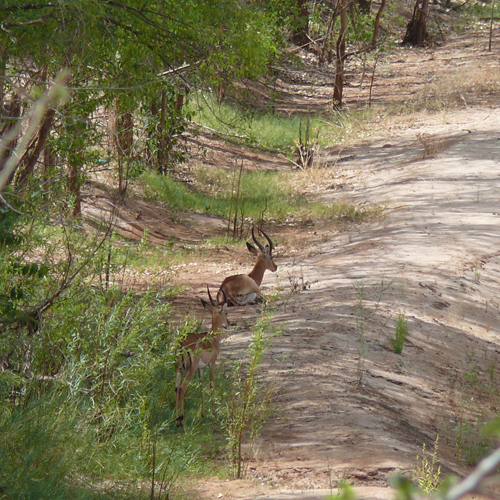
The baobab trees have only just dropped all their leaves, which had turned such a bright yellow colour that the trees looked like they were in blossom. They are now bare-boughed again. If the thunder and lighting outside my window beyond the Yatta have anything to say about it though, it seems the trees will be coming out in leaf before too long again…
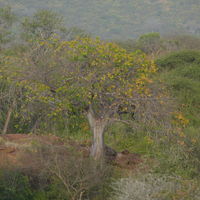
Yellow-leafed baobab tree - you would be forgiven for thinking it was in flower!
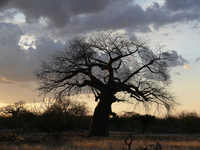
Bare-boughed baobab above the airstrip
Jean-Genie [plural – our genet cats - we initially thought there was just one, but now it now turns out there are at least two or three] have become tamer and tamer, and now come right up to our chairs when we’re on the balcony eating dinner. Soon they’ll be tame enough to photograph but I don’t want to frighten them away at this early, delicate stage by using the flash. What the genets leave behind, the ants tidy up – how about this for cooperative labour?
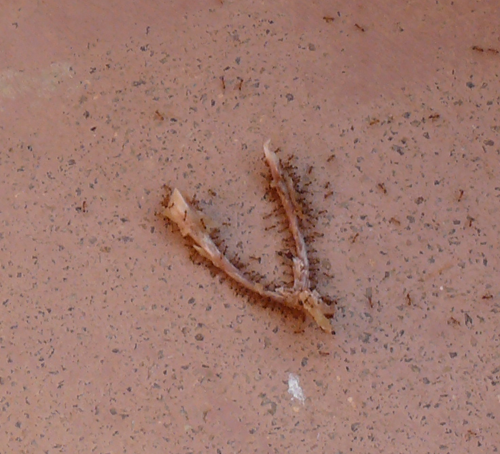
I apologise for the irregularity of my posting at the moment (and it’s going to get worse for a while, I’m afraid, but my workload is so heavy at the moment, that I just am too exhausted by the end of the day to start blogging…in time, things will get back to normal, and I’ll be here more regularly again…until then, I’ll be around, but it’s going to be sporadic for a while…
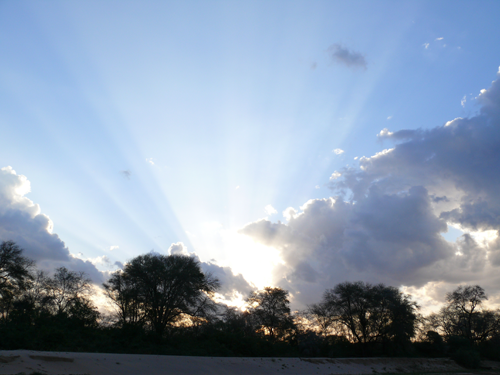
More in Pictures from March 2008:
Wild Animals
Birdlife
Tree Watch
Miscellaneous Views of the Landscape
Big African Skies
People Pics: Our Life in the Wild
Track Stories: Tales Left Behind in the Sand


